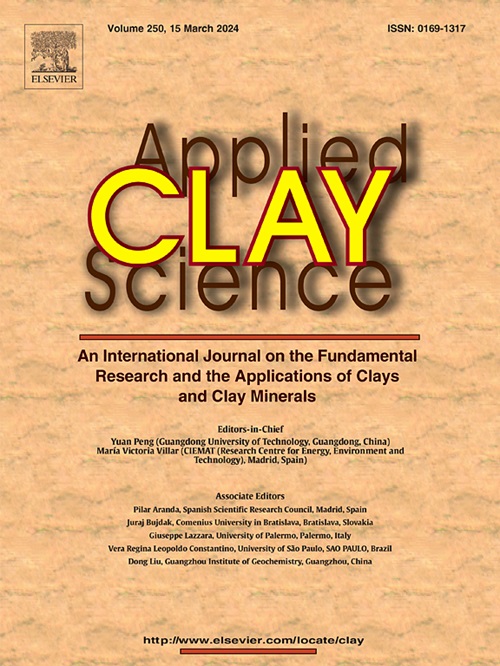非离子表面活性剂改性蒙脱土制备海藻酸盐/有机蒙脱土复合纤维疏水性药物配方
IF 5.3
2区 地球科学
Q2 CHEMISTRY, PHYSICAL
引用次数: 0
摘要
鉴于十二烷基聚葡萄糖苷(C12-APG)具有良好的界面活性和生物相容性,采用湿球磨法对天然蒙脱土钠(Na-Mt)进行有机改性,改变其强极性,增强其对疏水抗炎和抗菌药物的亲和力。将合成的有机蒙脱土(OMt)分散在海藻酸钠(SA)基体中,通过湿纺丝技术制备海藻酸钠/OMt复合纤维(Alg/OMt CFs),获得了良好的力学性能、增强的药物包封性和持久的药物释放性能。OMt表征结果表明,C12-APG对Na-Mt的有机修饰机制可以认为是物理插层,即在机械力的辅助下,C12-APG被物理插入到Na-Mt的中间层中,不仅扩大了d间距,提高了中间层中C12-APG的热稳定性,而且有效改变了Na-Mt的强极性,增强了其对疏水三氯生的亲和力。从而将其对三氯生的吸附量从34.965 mg/g提高到45.249 mg/g。此外,制备的Alg/OMt CFs具有连接的孔隙结构和规则的形态,其包封效率(EE)和载药量(DLC)分别高达92±3.1%和4.4±0.18%,表明OMt对三氯生具有良好的亲和力。Alg/OMt CFs可连续释放三氯生87 h,具有良好的缓释性能。最后,细胞毒性试验结果表明Alg/OMt CFs具有良好的细胞相容性。Alg/OMt CFs具有相互连接的孔隙结构、均匀的形态、高的载药量、良好的缓释特性和优异的细胞相容性,可以作为功能性伤口敷料领域的疏水抗炎和抗菌药物制剂。本文章由计算机程序翻译,如有差异,请以英文原文为准。
Fabrication of nonionic surfactant modified montmorillonite for alginate/organo-montmorillonite composite fibers based hydrophobic pharmaceutical formulations
In view of the excellent interfacial activity and biocompatibility of dodecyl polyglucoside (C12-APG), natural sodium montmorillonite (Na-Mt) was organically modified by C12-APG via wet ball milling approach to change its strong polarity and enhance its affinity to hydrophobic anti-inflammatory and antibacterial drugs. Furthermore, the resultant organo-montmorillonite (OMt) was dispersed in sodium alginate (SA) matrix to fabricate alginate/OMt composite fibers (Alg/OMt CFs) through wet spinning technique to achieve their good mechanical properties, enhanced drug encapsulation and durable drug release performance. The characterization results of OMt showed that the organic modification mechanism of C12-APG on Na-Mt was considered to be physical intercalation, that was, with the assistance of mechanical forces, C12-APG was physically inserted into the interlayer of Na-Mt, which not only enlarged the d-spacing and improved the thermal stability of C12-APG in the interlayer, but also effectively changed the strong polarity of Na-Mt and enhanced its affinity to hydrophobic triclosan, thereby improving its adsorption capacity to triclosan from 34.965 mg/g to 45.249 mg/g. Moreover, the fabricated Alg/OMt CFs exhibited connected pore structure and regular morphology, and their encapsulation efficiency (EE) and drug loading capacity (DLC) were as high as 92 ± 3.1 % and 4.4 ± 0.18 %, presenting good affinity of OMt to triclosan. Additionally, Alg/OMt CFs could release triclosan continuously for 87 h, displaying good sustained release performance. Finally, the results of cytotoxicity test indicated that Alg/OMt CFs had exceptional cytocompatibility. Given their interconnected pore structure, uniform morphology, high drug loading capacity, favorable sustained release characteristics, and exceptional cytocompatibility, Alg/OMt CFs could serve as a hydrophobic anti-inflammatory and antibacterial pharmaceutical formulation in the domain of functional wound dressings.
求助全文
通过发布文献求助,成功后即可免费获取论文全文。
去求助
来源期刊

Applied Clay Science
地学-矿物学
CiteScore
10.30
自引率
10.70%
发文量
289
审稿时长
39 days
期刊介绍:
Applied Clay Science aims to be an international journal attracting high quality scientific papers on clays and clay minerals, including research papers, reviews, and technical notes. The journal covers typical subjects of Fundamental and Applied Clay Science such as:
• Synthesis and purification
• Structural, crystallographic and mineralogical properties of clays and clay minerals
• Thermal properties of clays and clay minerals
• Physico-chemical properties including i) surface and interface properties; ii) thermodynamic properties; iii) mechanical properties
• Interaction with water, with polar and apolar molecules
• Colloidal properties and rheology
• Adsorption, Intercalation, Ionic exchange
• Genesis and deposits of clay minerals
• Geology and geochemistry of clays
• Modification of clays and clay minerals properties by thermal and physical treatments
• Modification by chemical treatments with organic and inorganic molecules(organoclays, pillared clays)
• Modification by biological microorganisms. etc...
 求助内容:
求助内容: 应助结果提醒方式:
应助结果提醒方式:


